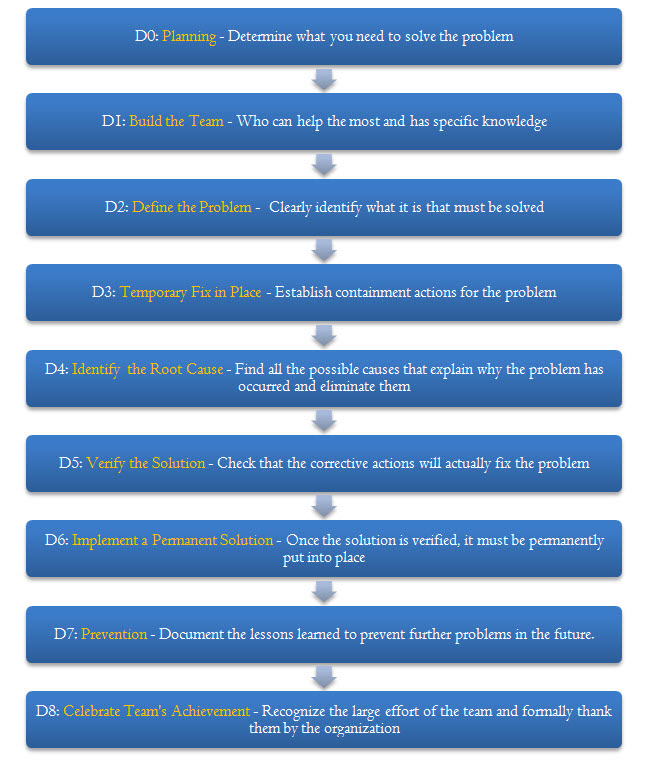Working in the engineering world is about analyzing and solving problems that we face with our designs, production lines and even in our environments as we work to build the highest quality automobiles in the industry. When we are faced with a problem, using an established problem solving process will help us to analyze the issue in the most thorough, quick and effective way possible and lead us to implementing a solution that is effective and well analyzed.
The 8 Disciplines or 8D problem solving method was developed by the Ford industry and helps to lead a team through the problem solving process that will identify the root cause of the issue and put controls in place so that it does not occur again. I have used this process many times in my engineering career, and I can say that it is one of the most effective tools to organize a group of people to actually solve a problem. The 8D Problem Solving Process is a tool that any team in any industry can use to solve problems in a quick, thorough and effective manner.
Outlining the 8D Process steps
The 8D problem solving method has 8 general disciplines and a planning phase. Each discipline is an important part of following the 8D process and skipping a step will definitely reduce the effectiveness of this tool. Even if time is short the team needs to follow each process step to reach the solution.
Figure 1 – 8 D Problem Solving Process

Discipline 0 – Planning
The first discipline of the process is planning and includes looking at the big picture within your company and what is the best strategy to address the problem. If the problem is a “line down” situation then the resources available will be much higher than if the problem can be contained to one machine and there is a temporary work around that can be put in place. This must be considered in the kick off phase. During the planning phase you need to establish the time frame, identify the team and the resources the team will need to solve the problem. Once these have been identified then it is time to move to the next discipline.
Discipline 1 – Build the Team
A good team will have all the necessary resources required to solve the problem and have their time made available to actively engage in the team to solve the problem (example, design engineering, manufacturing engineering, welding expert, materials expert, etc.). Once the team members are identified the next step is for the team to meet and establish a charter for the team activities. To build team work it can even be beneficial to try team building activities to encourage better trust and collaboration on the team (only with time of course).
Discipline 2 – Define the Problem
The next step of the process is to clearly identify what the problem is that must be solved. Sometimes problems can be ambiguous and the team must clearly identify the problem at hand using measurable details when possible. For example, a good problem definition is to eliminate dash board cracking during assembly to zero parts per minute (ppm) vs a bad example of ‘increase customer satisfaction’. Always be quantitative and avoid ambiguous statements. Clearly identifying the problem focuses the team and stops wasted effort.
Discipline 3 – Put a temporary Fix in Place
Damage control is one responsibility of the team which requires putting a temporary fix in place to stop the problem from getting to the customer. This could be a 100% visual inspection to catch a defective part, removing suspect inventory, using a different machine or tool or any combination of these things. These short term solutions must be implemented quickly to avoid more quality issues.
Discipline 4 – Identify the Root Cause
Once the temporary control has been put in place the team can now focus on finding the root cause of the problem. Tools like as a Cause and Effect Analysis or Five Whys are available that can assist them team in doing a deep dive into the problem. It is important to keep digging as the root cause is not always apparent when you first begin analysis and the team must be diligent and persistent. Once the root cause is identified it must be corrected to move on to the next step.
Discipline 5 – Verify the Solution
After the root cause is identified and corrected the next step is to double check that the solution did fix the problem. One way to verify that the root cause has been identified and fixed is if you can create or recreate the problem. Or the team can conduct a blind spot analysis to make sure that no stone has been left unturned and the true root cause has been identified.
Discipline 6 – Implement a Permanent Solution
When the team is confident that they have found the root cause and identified a solution then a permanent solution must be put in place. This could mean a change is made to the design, a material is changed to avoid a bad chemical interaction or that a process monitor is put in place to stop damage.
Discipline 7 – Prevention
A key to the success of the 8D problem solving process is that it helps prevent the process from occurring again. The team needs to document what happened and all their findings and then put procedures in place that will prevent future engineers from making the same mistakes in the future. These key learnings need to be documented in a secure location within the company so that the knowledge and experience isn’t lost.
Discipline 8 – Celebrate the Team’s Achievement
 When the team has completed their work it is important to recognize the team for their efforts. At a minimum a personal thank you to each team member recognizing their efforts is required but a larger celebration or recognition is necessary if a possible quality crisis was averted. Consider the savings to the company when determining how to recognize the team.
When the team has completed their work it is important to recognize the team for their efforts. At a minimum a personal thank you to each team member recognizing their efforts is required but a larger celebration or recognition is necessary if a possible quality crisis was averted. Consider the savings to the company when determining how to recognize the team.
Having the right tools to solve engineering problems when working in the automotive industry is key to building a quality product. The 8D problem solving process has proven successes and is a great tool to have in your arsenal when a problem comes up that must be solved quickly and effectively.
For more information:
http://www.mindtools.com/pages/article/8d-problem-solving.htm

